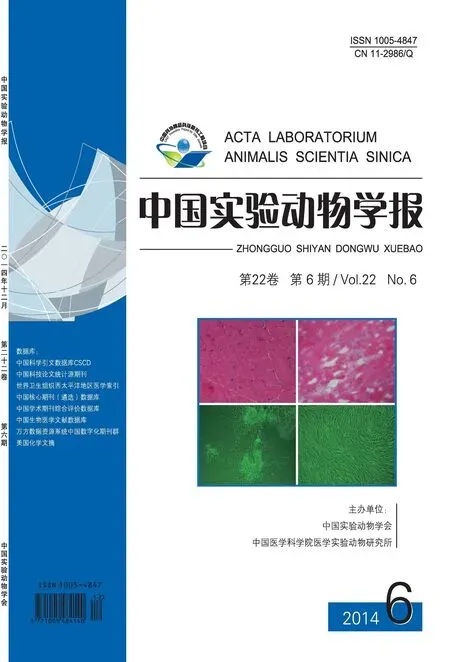毛丝鼠在医学研究中的应用
杨博超,肖冲,马喜山,刘云波
(中国医学科学院北京协和医学院实验动物研究所,北京 100021)
毛丝鼠(Chinchilla)学名南美洲栗鼠,别名琴其拉、绒鼠,是哺乳纲,啮齿目,豪猪亚目,毛丝鼠科,毛丝鼠属动物。毛丝鼠现存有两个种:长尾毛丝鼠(Chinchillalanigera)和短尾毛丝鼠(Chinchillabrevicaudata)。毛丝鼠原产于南美洲的安第斯山区,具有独特的生物学特性。由于其毛皮具有丝滑、轻盈、致密等独特优势,早在20世纪20年代初,美国即引进毛丝鼠,并随后开始大规模饲养。我国从20世纪70年代初开始引进,并实现成功饲养,尤在我国北方地区养殖效果良好。
毛丝鼠作为听觉系统、微生物及寄生虫感染动物模型用于生物医学研究,另可根据其独特的生物学特点,开发其在老年性疾病、代谢性疾病等方面研究的应用。本文对毛丝鼠的生物学特性作一介绍,并就其在医学研究中的应用进展作简要综述。
1 毛丝鼠的生物学特性
1.1 形态和品种特征
一般认为家养毛丝鼠为长尾毛丝鼠。长尾毛丝鼠体长24~28cm,尾长14 cm。成年母鼠比公鼠大,母鼠体重510~710 g,公鼠为425~570 g,初生仔鼠44.83±6.69 g[1]。短尾毛丝鼠的体长32 cm,尾长10 cm,颈部和肩部较厚,耳较小。毛丝鼠的黑眼睛大而亮,鼻侧长有长短不一的触须,触觉灵敏,耳壳大而薄,呈钝圆形。毛丝鼠耳蜗部位常见老年斑(senile plaque,SP),在耳蜗外细胞积聚。
1.2 生态和习性
毛丝鼠主要栖息在海拔2100~4500 m的高山岩石缝隙和乱石堆中。毛丝鼠缺乏汗腺,喜干燥凉爽的环境,以2~28℃为宜,不喜欢强光直射,昼伏夜出。草食性,野生毛丝鼠依靠采食鲜嫩多汁的草本植物或灌木的皮、茎和枝条,也喜食干草和种子。但给草食性动物过多的多糖,碳水化合物和脂肪会造成了此类动物类似于糖尿病的问题。靠后肢坐立,利用前肢的小爪将饲料送到嘴里[2]。喜清洁,爱沙浴,每周至少进行1 次沙浴,每次沙浴20~30 min。毛丝鼠是单排卵管动物,最早3月龄,最迟9~11月龄达性成熟,可在一年的任何时间繁殖,发情期可持续28~35d,毛丝鼠妊娠期为111d,每年能产仔2~3窝[3]。寿命为15~20 年,10 岁前有繁殖能力[4]。
2 毛丝鼠在医学研究中的应用
2.1 听觉系统研究
毛丝鼠首次应用于实验研究是用作听觉系统的实验[5]。毛丝鼠听觉范围(20~30000 Hz)和耳蜗大小与人非常接近,其内耳的解剖和生理学与人类的耳朵解剖学类似,耳蜗有三圈,一个咽鼓管鼓室[6],且耳蜗比较容易获得,是用做听觉系统研究的最佳动物模型,主要用于中耳炎及听力下降的研究[7, 8]。
毛丝鼠用于开发单一病原体引起的中耳炎模型,被认为是金标准。中耳炎是是中耳鼓室粘膜的炎症,多由细菌感染引起。累及中耳(包括咽鼓管、鼓室、鼓窦及乳突气房)全部或部分结构的炎性病变,好发于儿童。毛丝鼠可以用于制备肺炎链球菌导致的中耳炎模型[9-14];亦可直接接种流感嗜血杆菌至毛丝鼠中耳部位诱导中耳炎制备动物模型[15, 16];除此之外,毛丝鼠还可用于制备中耳胆脂瘤形成模型[17]及慢性鼓膜穿孔模型[18, 19]。作为重要的模型动物,毛丝鼠在耳相关研究中发挥着重要的作用。
2.2 微生物学研究
毛丝鼠对多种微生物易感,可感染李斯特菌、耶尔森氏菌[20]、铜绿假单胞菌[21]等病原,并可发生须癣毛癣菌感染[22]。有研究指出成年毛丝鼠是用于霍乱研究的合适动物模型[23-25],可用于相关毒素毒力研究及相应疫苗的免疫效力评价。
2.3 寄生虫学研究
毛丝鼠可感染利什曼原虫[26, 27]、贾地鞭毛虫[28-30]、球虫、短膜壳绦虫[31]、弓形体[32],可用作相应寄生虫感染研究。另外,毛丝鼠对南美锥虫高度敏感[33],已有学者开展了相应感染研究。
毛丝鼠已作为猪带绦虫的实验模型[34],具有稳定可重复等特点,应用效果良好[35],利于深入研究宿主-寄生虫的关系[36]。
2.4 老年病研究
毛丝鼠老龄化后耳蜗部位常见老年斑(senile plaque,SP)。发现老年斑在耳蜗外细胞积聚,靠近支持细胞及Reissner’s膜上皮细胞的内淋巴表面[37]。老年斑主要成分为β-淀粉样蛋白 (β-amyloid peptide,Aβ)[38],含有39-43个氨基酸不等[39]。Aβ具有神经毒性,为老年痴呆(AD)的主要致病因子之一[40]。但是 AD 的确切发病机制迄今尚不清楚,而当前AD致病机制的研究中,Aβ毒性假说占主导地位,Aβ的聚集和沉积被认为是中心环节。故开展毛丝鼠老年斑形成机制的研究,对老年痴呆的发病机制研究有重要指导意义。
2.5 高胆固醇血症研究
通过饲喂含10.0%动物油和0.5%胆固醇的食物可导致毛丝鼠的高胆固醇血症,可观测到其血清胆固醇水平的升高[41],可将毛丝鼠用于高胆固醇血症的治疗手段研究。
2.6 糖尿病研究
毛丝鼠摄食高糖、脂肪的食物易诱发糖尿病[42],而筛选患病动物周期较长。可通过链脲佐菌素诱导糖尿病,开发毛丝鼠糖尿病模型,为糖尿病的治疗研究提供有力的实验工具。
另外,毛丝鼠还可用于胃肠道疾病、肺炎、骨关节置换等方面研究[43]。
3 结语
实验动物资源是生命科学研究的重要支撑条件,我国现有的实验动物资源难以满足现代科学飞速发展的需求。因此,开发培育实验动物新资源,将一些有特殊生物学性状或对人类疾病研究有特殊价值的动物进行实验动物化,是生物医学的研究的必要前提。
毛丝鼠作为动物模型已经应用于听觉系统、微生物及寄生虫感染研究,由于其在老年性疾病、代谢性疾病等方面的特点,可进一步开发以用于相关研究。
因此,加强我国毛丝鼠资源开发应用,建立毛丝鼠作为实验动物的技术体系,加速我国毛丝鼠实验动物化的进程,以满足科研需求。
相信随着开发应用研究的不断深入,毛丝鼠在生物医学研究中的应用前景将更加广阔,对促进我国生物医药领域原创性研究成果的形成具有重要意义。
[1] 佟煜人,钱国成.毛丝鼠[M] 中国毛皮兽饲养技术大全, 中国农业科技出版社,1990,384-406.
[2] 李长生.毛丝鼠的开发价值[J].新农业,2010(09):50-51.
[3] 李长生.毛丝鼠的科学养殖与产品利用[J].林业实用技术,2009(08):50-52.
[4] 吴志杰,于亚艳,王艳萍,等.毛丝鼠繁殖[J].新农业,2010(09):51-52.
[5] Mast TE.Dorsal cochlear nucleus of the chinchilla: excitation by contralateral sound[J].Brain Res,1973,62(1):61-70.
[6] Tsuprun V, Schachern P, Paparella MM, et al.Ultrastructure of the basilar membrane in chinchilla cochlea[J].Otolaryngol Head Neck Surg,2003,129(2):P152-P153.
[7] Martin L.Chapter 43-Chinchillas as Experimental Models.The Laboratory Rabbit, Guinea Pig, Hamster, and Other Rodents[M].In Suckow MA, Stevens KA, Wilson RP,(Eds).Boston:Academic Press,2012,1009-1028.
[8] Murao MS, Sanchez TG, Bento RF.Transient evoked otoacoustic emissions after vestibular nerve section in chinchillas[J].Otolaryngol Head Neck Surg,2004,131(2):P161.
[9] Linder TE, Daniels RL, Lim DJ, et al.Effect of intranasal inoculation of Streptococcus pneumoniae on the structure of the surface carbohydrates of the chinchilla eustachian tube and middle ear mucosa[J].Microb Pathog,1994,16(6):435-441.
[10] Sabharwal V, Figueira M, Pelton SI, et al.Virulence of Streptococcus pneumoniae serotype 6C in experimental otitis media[J].Microbes Infection,2012,14(9):712-718.
[11] Johnson RW, Mcgillivary G, Deno⊇l P, et al.Abrogation of nontypeable Haemophilus influenzae protein D function reduces phosphorylcholine decoration, adherence to airway epithelial cells, and fitness in a chinchilla model of otitis media[J].Vaccine,2011,29(6):1211-1221.
[12] Chen S, Paterson GK, Tong HH, et al.Sortase A contributes to pneumococcal nasopharyngeal colonization in the chinchilla model[J].FEMS Microbiol Lett,2005,253(1):151-154.
[13] Jung TTK, Park SK, Rhee CK.Effect of inhibitors of leukotriene and/or platelet activating factor on killed H.influenzae induced experimental otitis media with effusion[J].Int J Pediat Otorhinolaryngol,2004,68(1):57-63.
[14] Tong HH, Mciver MA, Fisher LM, et al.Effect of lacto-N-neotetraose, asialoganglioside-GM1 and neuraminidase on adherence of otitis media-associated serotypes of Streptococcus pneumoniaeto chinchilla tracheal epithelium[J].Microb Pathogen,1999,26(2):111-119.
[15] Novotny LA, Clements JD, Bakaletz LO.Kinetic analysis and evaluation of the mechanisms involved in the resolution of experimental nontypeable Haemophilus influenzae-induced otitis media after transcutaneous immunization[J].Vaccine,2013,31(34):3417-3426.
[16] Hong W, Peng D, Rivera M, et al.Protection against nontypeable Haemophilus influenzae challenges by mucosal vaccination with a detoxified lipooligosaccharide conjugate in two chinchilla models[J].Microb Infect,2010,12(1):11-18.
[17] Wright CG, Bird LL, Meyerhoff WL.Effect of 5-fluorouracil in cholesteatoma development in an animal model[J].Am J Otolaryngol,1991,12(3):133-138.
[18] Skelton SC, Darrow D, Kuhn JJ.R165: Chronic TM perforation model in the Chinchilla[J].Otolaryngol Head Neck Surg,2006,135(2, Suppl):P162.
[19] Kim S, Esquivel CR, Grafenberg MR.Use of elastin patch for repair of traumatic tympanic membrane perforation in chinchillas[J].Otolaryngol Head Neck Surg,2004,131(2):P281.
[20] Wuthe H, Aleksic S.Yersinia enterocolitica serovar 1,2a,3 biovar 3 in chinchillas[J].Zentralblatt für Bakteriologie,1992,277(3):403-405.
[21] 钱国成.动物的绿脓杆菌病[J].毛皮动物饲养,1982(02):52-53.
[22] Male O, Fritsch P.[Trichophyton mentagrophytes-caused epidemic and enzootic disease in a chinchilla farm][J].Mykosen,1966,4(2):74-84.
[23] Blachman U, Goss SJ, Pickett MJ.Experimental cholera in the chinchilla[J].J Infect Dis,1974,129(4):376-384.
[24] Blachman U, Graboff SR, Haag GE, et al.Experimental cholera in Chinchillas: the immune response in serum and intestinal secretions to Vibrio cholerae and cholera toxin[J].Infect Immun,1974,10(5):1098-1104.
[25] Green BA, Doyle WJ, Cowell JL.Chinchilla model of experimental otitis media for study of nontypable haemophilus intluenzae vaccine efficacy[M] Methods in Enzymology, Virginia L.Clark PMB, Academic Press,1994: Volume 235,59-68.
[26] Stauber LA, Ochs JQ, Coy NH.Electrophoretic patterns of the serum proteins of chinchillas and hamsters infected with Leishmania donovani[J].Exp Parasitol,1954,3(4):325-335.
[27] Rossan RN.Serum proteins of animals infected with Leishmania donovani, with special reference to electrophoretic patterns[J].Exp Parasitol,1960,9(3):302-333.
[28] Meyer EA.Isolation and axenic cultivation of Giardia trophozoites from the rabbit, chinchilla, and cat[J].Exp Parasitol,1970,27(2):179-183.
[29] Veronesi F, Piergili Fioretti D, Morganti G, et al.Occurrence of Giardia duodenalis infection in chinchillas (Chincilla lanigera) from Italian breeding facilities[J].Res Vet Sci,2012,93(2):807-810.
[30] Levecke B, Meulemans L, Dalemans T, et al.Mixed Giardia duodenalis assemblage A, B, C and E infections in pet chinchillas (Chinchilla lanigera) in Flanders (Belgium)[J].Vet Parasitol,2011,177(1-2):166-170.
[31] 吕超超,王鹤磊,齐萌,等.宠物毛丝鼠肠道寄生虫感染情况调查[J].中国畜牧兽医,2009(05):176-177.
[32] 田岛嘉雄,高竞一.毛丝鼠的饲养与繁殖[J].毛皮动物饲养,1983(04):47-48.
[33] Bafort JM, Kageruka P, Timperman GT.A new, highly susceptible laboratory animal for Chagas’s disease[J].Trans R Soc Trop Med Hyg,1973,67(4):434-435.
[34] Basso W, Rütten M, Deplazes P, et al.Generalized Taenia crassiceps cysticercosis in a chinchilla (Chinchilla lanigera)[J].Vet Parasitol,2014,199(1-2):116-120.
[35] Maravilla P, Garza-Rodriguez A, Gomez-Diaz B, et al.Chinchilla laniger can be used as an experimental model for Taenia solium taeniasis[J].Parasito Int,2011,60(4):364-370.
[36] á vila G, Teran N, Aguilar-Vega L, et al.Laboratory animal models for human Taenia solium[J].Parasitol Int,2006,55, Supplement(0):S99-S103.
[37] Bohne BA, Gruner MM, Harding GW.Morphological correlates of aging in the chinchilla cochlea[J].Hear Res,1990,48(1-2):79-91.
[38] Iqbal K, Grundke-Iqbal I, Smith AJ, et al.Identification and localization of a tau peptide to paired helical filaments of Alzheimer disease[J].Proc Natl Acad Sci U S A,1989,86(14):5646-5650.
[39] Masters CL, Simms G, Weinman NA, et al.Amyloid plaque core protein in Alzheimer disease and Down syndrome[J].Proc Natl Acad Sci U S A,1985,82(12):4245-4249.
[40] Yankner BA, Duffy LK, Kirschner DA.Neurotrophic and neurotoxic effects of amyloid beta protein: reversal by tachykinin neuropeptides[J].Science,1990,250(4978):279-282.
[41] Henderson Jr.JD, Webster WS, Clarkson TB.Diet-induced hypercholesterolemia in the chinchilla and rabbit[J].Atherosclerosis,1970,12(3):341-348.
[42] Brown C, Donnelly TM.Cataracts and reduced fertility in degus (Octodon degus).Contracts secondary to spontaneous diabetes mellitus[J].Lab Anim (NY),2001,30(6):25-26.
[43] Mcdowell MP, Kuhn JJ, Strasnick B.Incudostapedial joint reconstruction using dahllite bone cement in a chinchilla model[J].Otolaryngol Head Neck Surg,2005,133(2, Suppl):P83-P84.

